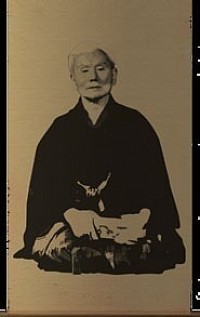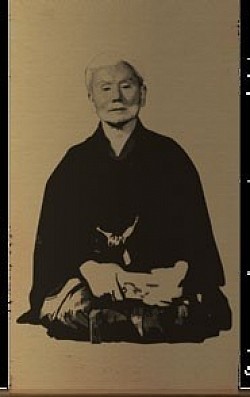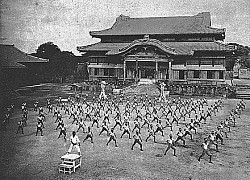The Origins of Karate & Master Funakoshi
The Evolution of Karate
Karate history can be traced back some 1400 years, to Daruma, the founder of Zen Buddhism in Western India. Daruma, or Bodhidharma, is said to have introduced Buddhism into China, incorporating spiritual and physical teaching methods that were so demanding that many of his disciples would drop in exhaustion. In order to give them greater strength and endurance, he developed a more progressive training system, which he recorded in a book, Ekkin-Kyo, which can be considered the first book on Karate of all time.
The physical training, heavily imbued with Daruma's philosophical principles, was taught in the Shaolin Temple in the Henan province from the year 500 AD.
The term Kempo, literally meaning "method of the fist" is used in Japanese to refer to Chinese martial arts. Kempo represents the essence of Shaolin; Shorei Kempo and Shorin Kempo came to represent the styles of the martial arts from the Shaolin Temple.
Development of Karate in Ryukyu Islands
The Ryukyu Kingdom existed from 1429–1879, at which time it was annexed to Japan, and thereafter known as Okinawa.
A large group of Chinese families moved to Okinawa around 1392 for the purpose of cultural exchange, and shared their knowledge of a wide variety of Chinese arts and sciences, including the Chinese martial arts. The political centralization of Okinawa by King Shō Hashi in 1429 and the policy of banning weapons by King Shō Shin in 1477, later enforced in Okinawa after the invasion by the Shimazu clan in 1609, are also factors that furthered the development of unarmed combat techniques in Okinawa.
The suggestion that karate developed as a result of a complete ban on weaponry is a here, and the suggestion that Okinawan kobudō was developed as a result of a ban on commoners owning swords even more so. There were several times in Ryūkyū’s history that weapons restrictions were implemented, but never a total weapons ban; and the Ryūkyūan peasantry never owned swords due to a lack of battlefield martial arts among commoners and the high price of metal in Ryūkyū.
Each of the historical weapons restrictions were more focused than a total ban, often targeting select weaponry like the martial weapons used by warriors; including firearms, bows, and swords; or ship weapons used by pirates; including swords and small arms. Defensive or peace-keeping weapons like the sai were not included in these bans.
Further in-depth history of Ryukyu and Okinawa is available here and with The Karate Handbook resource.
Master Funakoshi and Creation of Shotokan Style
Gichin Funakoshi, the founder of Shotokan Karate and considered the Father of Modern Karate, was born on 10 November, 1868 in Yamakawa, Shuri, Okinawa.
Shotokan is named after Funakoshi's pen name, Shōtō (松濤), which means "waving pines". Kan means training hall or house, thus Shōtōkan (松濤館) referred to the "house of Shōtō". This name was coined by Funakoshi's students when they posted a sign above the entrance of the hall at which Funakoshi taught. In addition to being a karate master, Funakoshi was an avid poet and philosopher who would reportedly go for long walks in the forest where he would meditate and write his poetry.
Funakoshi learned under the expertise of the revered Sensei Itosu (1831 - 1915) and Sensei Azato (1827 – 1906), who were taught by the legendary Master Matsumura Sokon. Some consider Sensei Itosu Anko as The Grandfather of Modern Karate.
One of the few people to have been initiated into all the major Okinawan Karate methods, Master Funakoshi taught a synthesis of the major Okinawan styles, Shōrin-ryū (Shuri-te) and Shōrei-ryū (Naha-te) as a total discipline. He thus created a simpler system that combined the ideals of the two. He never named this style, however, always referring to it simply as "karate", but ultimately this method became known as Shotokan (literally "house/school (kan) of pine waces (Shoto was to become Funakoshi's pen name)”. Funakoshi transformed these Kanji into an "empty hand". He also added the character "Do" (the path, the way) at the end of the word Karate.
“Karate” was then brought by Sensei Funakoshi to Japan, when he was invited in 1922 to perform at a physical education exhibition sponsored by the Ministry of Education. Many high-ranking judo practitioners were in attendance and were deeply impressed by the martial art of karate. Such was the success of his exhibition and acceptance of karate, Master Funakoshi remained in Tokyo decided to teach and promote his art.
Master Funakoshi changed the names of some of the kata in an effort to make the Okinawan kata names easier to pronounce in the Japanese dialect.
In 1924, Funakoshi adopted the Kyū / Dan rank system and the uniform (keikogi) developed by Kano Jigoro, the founder of Judo. This system uses colored belts (obi) to indicate rank. Originally, karate had only three belt colors: white, brown, and black (with ranks within each). The original belt system, still used by many Shotokan schools, is:
8th rising to 4th kyū: white
3rd rising to 1st kyū: brown
1st and higher dan: black
In 1930, Funakoshi established an association named Dai-Nihon Karate-do Kenkyukai to promote communication and information exchange among people who study karate-do. In 1939, Funakoshi built the first Shōtōkan Dojo (training hall) in Tokyo.
In the air raids of World War II, the Shotokan dojo was destroyed, and the growth of karate came to a halt. But after the war, followers of Funakoshi’s way re-grouped, and in 1949 they formed the Japan Karate Association (JKA), with Gichin Funakoshi as Supreme Master.
However in practice this organization was led by Masatoshi Nakayama. The JKA began formalizing Funakoshi's teachings, although Funakoshi was not supportive of all of the changes that the JKA eventually made to his karate style.
On April 10, 1957, the Ministry of Education gave official recognition to the JKA, and it became a legal entity. Sixteen days later, aged 88, Master Funakoshi passed away. A large public memorial service was held at the Ryogoku Kokugikan (Ryogoku National Sumo Hall), attended by more than 20,000 people, including many famous names who came to pay their respects.
Because of the great popularity of the style in Japan and, later, around the world, Funakoshi is widely considered to be the "Father of modern Karate-do."
Shotokai (松濤會, Shōtōkai) is the organisation formed originally in 1930 by master Gichin Funakoshi to teach and spread the art of karate-do. The organization still exists and promotes a style of karate that adheres to Funakoshi's teachings, in particular the notion that competition is contrary to the essence of karate. Shotokai also designates a formal practice method.
Famous Students of Funakoshi:
Isao Obata, Shigeru Egami, Teruyuki Okazaki, Taiji Kase,Tetsuhiko Asai, Masatoshi Nakayama, Hirokazu Kanazawa, Hidetaka Nishiyama, Tsutomu Ohshima, Taiji Kase, Mitsusuke Harada, Gigō Funakoshi.
Role of Gigo Funakoshi
Gigō Funakoshi (1906 - 1945) was the third son of Gichin Funakoshi and is widely credited with developing the foundation of the modern karate Shotokan style.
Gigo Funakoshi was also born in Okinawa and diagnosed with tuberculosis at the age of seven. He was sickly as a child and began the formal study of karate-do at the age of twelve as a means to improve his health. In the early years, Gichin Funakoshi often took Gigo with him to his trainings with Yasutsune Itosu.
Gigō began to develop a karate technique that definitively separated Japanese karate-do from the local Okinawan arts. Between 1936 and 1945, Gigo gave it a completely different and powerful Japanese flavour based on his study of modern kendo (the way of the Japanese sword), and Iaido (the way of drawing the Japanese sword) under sensei Nakayama Hakudō. Gigo's work on Japanese Karate development was primarily popularized by masters Shigeru Egami and Genshin Hironishi, who later formed the Shotokai karate style.
Through his teaching position and understanding of Japanese martial arts, Gigō became the technical creator of modern Shotokan karate. In 1946 the book Karate Do Nyumon by Gigo and Gichin Funakoshi was released. Gigo had written the technical part, whereas his father Gichin wrote the preamble and historical parts.
Gigō developed long distance striking techniques using the low stances found in old style kendo and Iaido kata. Gigo also developed higher kicks including mawashi geri, yoko geri kekomi, yoko geri keage, fumikiri, ura mawashi geri and ushiro geri kekomi by referring to the foot technique of savate. All these techniques became part of the already large arsenal brought from the ancient Okinawan styles. A major development of Gigo was the introduction of the Kiba Dachi instead of Shiko Dachi and implementing the Kokutsu Dachi (which he took from Japanese classical fencing or "kenjutsu") instead of Neko Ashi Dachi stance in Shotokan Kata.
Gigō's kumite (fighting) style was to strike hard and fast, using low stances and long attacks, chained techniques and foot sweeps (taken from old style Kendo and Judo). Integration of these changes into the Shotokan style immediately separated Shotokan from Okinawan karate. Gigo also emphasized the use of oi tsuki and gyaku tsuki. The training sessions in his dojo were exhausting, and during these, Gigo expected his students to give twice as much energy as they would put into a real confrontation. He expected this over-training would prepare them for an actual combat situation, should it arise.
The difficult living conditions of World War II weakened Gigo, but he continued training. He died of tuberculosis at the age of 39 on 24 November 1945, in Tokyo, Japan.





